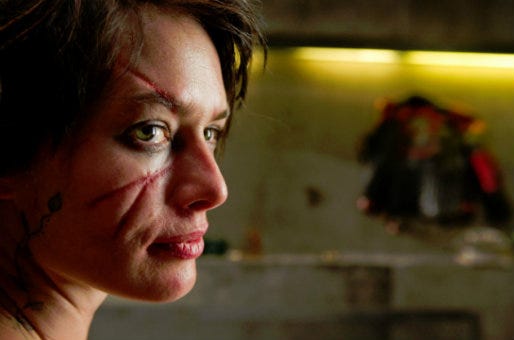Dredd 3D

At its heart, "Dredd 3D" is more Carpenter than Bay, more Die Hard than Commando. Take a look at the synopsis:
"In a violent, futuristic city where the police have the authority to act as judge, jury and executioner, a cop teams with a trainee to take down a gang that deals the reality-altering drug, SLO-MO."
Not to presume your persuasions, but if you're anything like the rest of America, this apparently doesn't appeal to you. Dredd is currently flopping at the box office, and a film with this much earnest style and substance deserves far more attention.
An opening monologue sets the scene: MegaCity 1, a vast urban center stretching between post-apocalypse Boston and Washington D.C. The world beyond the city is irradiated wasteland. Inhabitants of the city live in enormous structures that are minor cities in their own right. Crime runs rampant, but not without recourse. Mega City 1 is protected by Judges, elite peacekeepers who are judge, jury, and executioner.
Look: Dredd 3D, the last comic book film of the summer, is by far the most internally consistent of the lot. The film follows two characters, Judge Dredd (Karl Urban) and the Rookie (Oliva Thirlby), on a routine homicide investigation in Peach Tree, a tenement block controlled by drug lord Ma-Ma (Lena Headey). All of the action takes place within the confines of Peach Tree. Due to circumstance, there is little intervention from the outside world. Dredd and Rookie are on their own. The lack of story sprawl allows the characters to grow and, somewhat counter-intuitively, the world to expand.
The film has 94 minutes, and spends every last one with a ruthless efficiency. Aside from the opening and closing monologues, what we learn of Mega City 1 comes from offhand dialog. Mutants, for instance, exist as a result of the Atomic Wars decades before. We learn that Judges, and by extension their justice, has little effect on the day-to-day life of MC1 inhabitants. We also come to learn the nuances of a Judge's justice, bringing Dredd into a much more interesting character space. Thanks to tight dialog and editing, the film feels like we're looking in on a world, rather than watching people meander through set pieces. There are few plot holes or contrived character choices. The film feels complete.
Ultimately action solves all character conflicts (it's still an action movie, after all), but the carnage is choreographed to feel like well-deserved resolution rather than cheap slaughter. Slow motion is used minimally, and even then it has a plot context for appearing. For the most part all of the action beats are fast-paced and meaningful, progressing the story and characters.
Dredd's consistency extends to its style. There is no doubt in my mind that the film benefits from 3D. A 200-story skyscraper has never felt so tall or bullet-time more graphic. The music is largely 80's style slow, deep synth beats, which I personally prefer in my action films over the recent post-Inception hornblow fad.
Dredd 3D was released at an odd time of the cinematic year. The comic craze has died for a few months and the Christmas tentpoles are starting to release T.V. spots. It was successful across the pond, and it deserves and equally enthusiastic audience in the United States. If you're interested in a thoughtfully made action film with an ounce of subtlety, Dredd 3D is worth your while.


